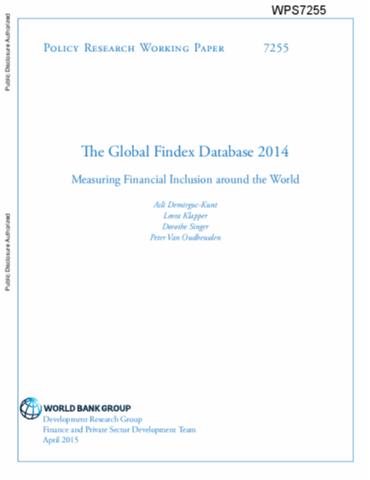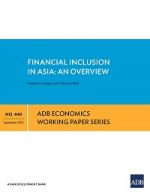Financial Inclusion
East and Southeast Asian countries are ageing fast and a key challenge of this demographic trend is the capacity of women to meet financial needs in old age

World Bank (2014) Measuring Financial Inclusion around the World
Type: Report | General
Access: Public
“The Global Financial Inclusion (Global Findex) database, launched by the World Bank in 2011, provides comparable indicators showing how people around the world save, borrow, make payments, and manage risk. The 2014 edition of the database reveals that 62 percent of adults worldwide have an account at a bank or another type of financial institution or with a mobile money provider. Between 2011 and 2014, 700 million adults became account holders while the number of those without an account—the unbanked—dropped by 20 percent to 2 billion.”

“This paper provides an analysis of financial development and inclusion in developing Asia using data from a wide array of sources. We show that in terms of aggregate measures of financial development, the region as a whole has superior banking sector depth compared to other developing regions; however, this masks a great deal of variation across Asian economies. Furthermore, in terms of financial inclusion, fewer than 27% of adults in developing Asia have an account in a formal financial institution, and only 33% of enterprises report having a line of credit or a loan from a financial institution. Cost, geographic access, and lack of identification are the most commonly reported barriers to financial inclusion that can be addressed by policy makers.”

“The aim of this review is to identify interventions which attempt to address the economic barriers faced by girls and young women, in low- and lower-middle income countries, and fragile states. The hypothesis is that if interventions both provide direct access to economic assets for young girls and tackle the wider social issues which impede girls and young women’s opportunities to access, build and protect economic assets, this will (i) support their immediate economic, social and psychological well-being (ii) improve their chances of economic success through the accumulation and control of economic assets and (iii) potentially help girls and young women to reframe/change wider social/societal relations.
This review addresses the following questions: (i) what is the impact of economic asset-building and/or protecting programmes for girls in low- and lower-middle income countries, and fragile states? and (ii) what are girls and young women’s views and experiences of participating in asset-building and/or protecting programmes in low- and lower-middle-income countries, and fragile states?”
World Bank Global Financial Inclusion Index (Findex) Database
Type: Dataset | General
Access: Public
IFC(2013) Strengthening Access to Finance for Women-Owned SMEs in Developing Countries
Type: Report | General
Access: Public
ADB(2015)Financial Inclusion, Education, and Regulation in the Philippines
Type: Report | Asia
Access: Public
ADB(2015) Financial Inclusion, Poverty, and Income Inequality in Developing Asia
Type: Online Portal | General
Access: Public
Type: Report | Global
Access: Public
Type: Journal Article | Asia
Access: Public